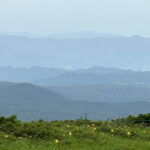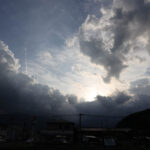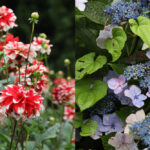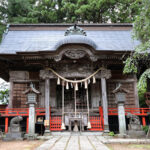10 July 2023 Monday
Sunny afternoon
Top of 33 degrees
We left Matsushima at 11 am, after visiting the Zuigan-ji, Sankei-den inside the Entsu-in and the Tenrin-in temples. We drove through Sendai, stopped for lunch at Michinoku Centre by Kamafusa Lake at midday on National Highway 286 in Kawasaki. We arrived in Togatta Onsen just before 1 pm.
We parked in the free car park outside the town Kattamine Shrine. The Founder and Director of the Togatta Maruyoshi Artists’ Residency, Satoh Masanori (44) met us and took us to our lodging and studio, a former fish shop between an izakaya Mikoshi and a soba shop, Shoan, across the street from the Togatta Event Park.

Togatta Maruyoshi Artist Residence between an izakaya Mikoshi and a soba shop, Shoan. Photo Mayu Kanamori
After meeting Intan Anggita Pratiwie (36), an Indonesian recycling artist and a sustainable fashion researcher, another artist in residence, we went for a short walk around town. We first visited Ozeki-ya, an antique kokeshi doll shop, then walked past a butcher, a souvenir shop, a liquor shop, two tofu shops, two public onsens, more than a dozen eateries and four ryokans; there were more hotels we could see in the distance.
We walked to Matsu-kawa River and the Kokeshi-bashi Bridge, then turned back, walking along the western side of the town. We passed a police station, a grocery shop, a taxi depot, and a Seven-Eleven convenience store. We soaked our feet in an ashiyu, a public foot bath, between the public bath Kami-no-yu and the Zao-machi Town Tourist Information Centre.
Satoh-san returned about 5 pm and took me to visit Kimura Yoko-san at the Kimura Shoten, a liquor store that sells local sake, shochu, souvenirs and more. Kimura-san is the organiser of the local tanka club. She said that the club members met every four months or so with a teacher from Sendai. I explained our project to her. She thought that their members were getting too old to become involved in an arts project.
She questioned whether utamakura poetry places can be created, because they are places that already exist, and cited Sue-no-matsuyama, two pine trees on top of a hill in Tagajo City, and sung by many, including 10th century Heian poet, Fujiwara no Okikaza (dates unknown) in the early Heian Period, Kiyohara no Motosuke (908−990) and Matsuo Basho (1644–1694).
I bought a bottle of Zao sake called Natsu no Hi for Martin and went back to our studio residence.
At 6 pm we ate dinner next door at Mikoshi. On our way to the bathhouse, on the street, we met Nagai Kyoka-san (26), who works with Satoh-san. She had visited us earlier to introduce herself and to discuss visiting Shiroishi together. Nagai-san is from Shiroishi and lives there.
We were too late for the public bath, Kami-no-yu, so Nagai-san took us across the street to meet the owners of Genbei, a ryokan with a bath we could use. Satoh-san had previously mentioned that Maruyoshi had an arrangement with this inn.
We turned our lights off just after 8pm.








Recent Comments